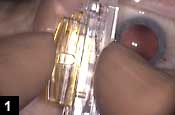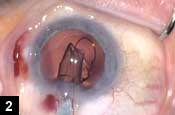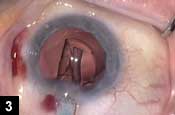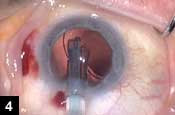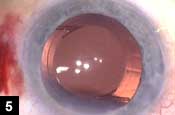Pre-loaded aspheric IOL simplifies injection, reduces surgery time
Device reduces surgical time and can be used with one hand, to give physicians better control of astigmatism and aberrations.
 Roberto Bellucci |
A new pre-loaded IOL injection system will simplify IOL implantation and reduce surgical time, according to one surgeon.
Roberto Bellucci, MD, said the KS-3Ai pre-loaded injection system from STAAR Surgical is a single-piece device that implants the aspheric IOL through a 2.75-mm incision, to give the surgeon better control of astigmatism and aberrations, which are more common with larger incisions.
“The injection maneuver can be performed with only one hand, not requiring any injector rotation during IOL delivery,” Dr. Bellucci told Ocular Surgery News in an e-mail interview. “In my opinion, this system will increase the number of silicone supporters within the ophthalmic community because it solves many of the problems of silicone IOL implantation.”
Aspheric lens
The KS-3Ai, launched in Japan in July 2004 and internationally at the 2006 European Society of Cataract and Refractive Surgeons meeting in London, is a three-piece biconvex IOL with a 6-mm silicone optic and polyamide haptics, Dr. Bellucci said. The lens has a total length of 12.5 mm, and it features double square edges on the posterior and anterior surfaces of the lens.
“The anterior lens surface is designed aspheric, to compensate for the positive spherical aberration of the cornea,” Dr. Bellucci said.
The lens is available from 12.5 D to 28.5 D in 0.5 D increments, according to Dr. Bellucci.
The loops of the lens offer “superior resistance” compared with PMMA loops materials, giving the IOL more stability inside the capsular bag, Dr. Bellucci said.
“The IOL corrects for the corneal spherical aberration, offering the advantages of aspheric design,” he said.
Preparing the lens
“Surgical time to prepare the lens for implantation is a fraction of the time required to open the cartridge and lens, and to load the lens when competitor injector systems are used,” Dr. Bellucci said. “You have only to fill the cartridge with viscoelastic and press the lens carrying case (Figure 1). When the nurse prepares the lens, the pre-loaded system adds safety to the whole procedure.”
Dr. Bellucci said the recommended incision size for this lens is 2.75 mm, “to allow the cartridge tip to enter the eye.”
This is the narrowest incision for a three-piece silicone IOL at this time, Dr. Bellucci said.
Pre-loaded system
The tip of the injector is designed to facilitate an easy placement of the lens. Another advantage of the pre-loaded system is that it increases sterility.
“The lens is never touched by any surgical instrument during preparation or implantation. In addition, the lens cannot be contaminated by dust or micro-particles that sometimes come in touch with IOLs, entering the eye with possible postoperative inflammation,” Dr. Bellucci said. “To be of real advantage, any pre-loaded system also has to be safe, not damaging the lens at any time, and effective, providing uncomplicated injection. The STAAR system provides both.”
|
|
|
|
|
|
| Images: Bellucci R |
Injecting the lens
When injected, the KS-3Ai unfolds gently (Figures 2 and 3), “because the side cut of the tip helps the cartridge to absorb the elastic force of the IOL during unfolding,” Dr. Bellucci said.
The unfolding of the lens is uniplanar so it does not require the surgeon to rotate the cartridge or injector once placed into the incision.
“After unfolding, the C-shaped piston tip can be used as a surgical manipulator and employed to grasp the second loop and to push it into position (Figure 4), thus completing the ‘no-touch’ implantation,” Dr. Bellucci said. “The implanted lens always stays nicely centered (Figure 5) because of the shape and strength of the haptics.”
For more information:
- Roberto Bellucci, MD, can be reached at Ophthalmic Unit, Hospital of Borgo Trento, 37126 Verona, Italy, +39-045-812-3035; fax: +39-045-812-2289; e-mail: roberto.bellucci@azosp.vr.it. He has no financial interest in any of the products mentioned in this article.
- STAAR Surgical AG, maker of the KS-3Ai aspheric IOL, can be reached at Haupstrasse 104, Postfach 463, CH-2560 Nidau, Switzerland; +41-32-332-8888; fax: +41-32-332-8899; Web site: www.staar.com.
- Daniele Cruz is an OSN Correspondent based in Collingswood, U.S.A.

